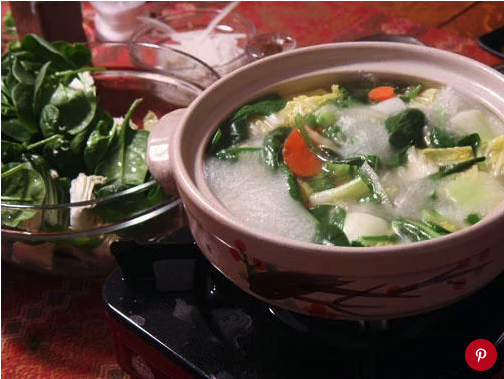Cold-Weather Goodness: Japanese Nabe

CL.COM EDITOR February 26, 2009
My husband and I started a new family tradition: Nabe Night. (It's our healthful twist on his family's weekly steak night.) This cozy, cook-at-your-table meal is our new cold-weather favorite -- light yet filling, elegantly simple, and perfect for sharing with family and friends. It feels like a special-occasion spread, but it's easy enough to do every week.
What it is: Nabe is short for nabemono (Nah-beh-MOH-noh), a Japanese word that loosely translates to"yummy stuff in a pot." It usually refers to communal one-pot mealsthat are cooked at the table in a delightfully intimate process that Idescribe to friends as "Japanese fondue." You might be familiar with sukiyaki, a stir-fried meal cooked on a communal or table-top grill at some restaurants. This is a similar concept, but the food is simmered, not stir-fried.
How it's made: The centerpiece of the meal -- literally and figuratively -- is a pot of broth simmered at the table. The communal pot is surrounded by platters of raw vegetables and a protein (meat, fish, or tofu) cut into bite-sized pieces, which guests place in the hot liquid to cook. When the food is tender, participants pluck it out with their chopsticks bit by bit and season each bite (watch out -- it's piping hot!) in little individual bowls filled with dipping sauces. Participants refill the pot with more fresh ingredients as they go. The broth evolves over the course of the meal, until in a sort of grand finale, it is ladled atop bowls of steaming noodles and slurped (as custom holds) quite loudly.
While Nabe feels fit for a special occasion, it's remarkably easy if you've got the right stuff. (Read on for more...)
Preparation: The prep mostly involves chopping fresh ingredients: Chinese cabbage or bok choy, carrots, mushrooms (shiitake, straw, or enoki), bamboo shoots(I use canned), green onions, spinach, and other veggies I have on hand. The protein can be chicken, beef, or tofu. For shabu-shabu, a beef-based nabe whose name means "swish-swish" (the motion of swirling the beef in the broth with your chopsticks) I buy a pound or so of beef pre-cut into paper-thin slices at the Asian market. You can also ask your butcher to slice it extra-thin, or you can freeze it for easier slicing yourself.
Broth: This is the most interesting part of the meal. It starts very simply, with a 4-inch square piece of kombu (dried kelp) in a pot of cold water. After folks are seated at the table, I bring the water to a boil, removing the kombu before the boiling point. As people add, cook, and remove ingredients during the meal, the broth grows richer and more complex. It always tastes a little bit different depending on the ingredients and the guests. Certain recipes, such as tori nabe, a chicken-based dish, call for a chicken broth prepared in advance on your stovetop. I've never tried using commercial broths, but I suspect they'd be too salty and would ruin the delicate flavor of this dish.
Sauces: The trickiest part of the meal is making the dipping sauces, whichvary slightly depending on the dish. If I'm cooking chicken (preferably dark meat with the bones), I grate fresh daikon (a mild Japanese radish you can find at some supermarkets and most Asianmarkets) and add a dash of lemon and soy sauce. If I'm making beef, I use two different, complementary sauces. One is a rich, thick sauce with a base of ground toasted sesame seeds thinned by vinegar, soy sauce, sake, and mirin. The other is a lighter, thinner, acidic sauce with lemon and soy.
Recipes: My recipes come from a 1986 cookbook called The Poetical Pursuit of Food, but you can find more contemporary ones by searching the blogosphere. Check out Just Hungry's recipe for Tori Nabe (chicken and vegetable hot pot). For the sauces, you could cheat and buy a pre-made version. (But why, when fresh is best?)
Tools: If you love kitchen gadgets, this is a fine excuse to invest in some (reasonably affordable) gear:a table-top gas burner (kind of a like a camp stove for indoor use -about $25-40, with gas cartridges that cost about $2) anda donabe (an earthen casserole, about $23). You can find these in most Asian markets. You can definitely make a version of nabe on your stove-top with aregular pot, but you'll miss the intimacy and fun of a table-top meal.


